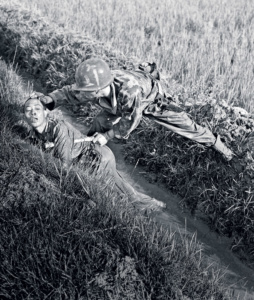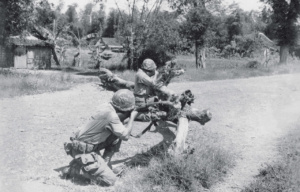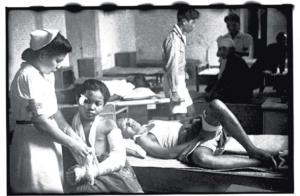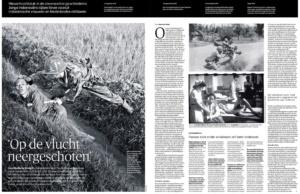Killed on the run
Extreme violence by Dutch troops against Indonesians in 1945-’50 was exceptional, is the official statement for decades. Only now, a historian thoroughly searched the archives and personal testimonies for “excesses”. He is the first to state that crimes against Indonesians were no exception but happened structurally.
By Anne-Lot Hoek, NRC August 15, 2015
One Sunday morning in 1948, an army truck full of soldiers of the Land Army gets fire on its way to a church service on Java. A soldier gets a shot in his head. What happens then, describes Louis Sinner, one of the soldiers in the truck in a personal testimony which is in the National Archives. “The commander, Major Van de Leede, grabbed the map and a drawing compass, jabbed the compass in the coordinates of the shooting incident, drew a circle and three companies transformed everything within that circle in Sodom and Gomorrah. What happened there was pure revenge, and worse than Putten [a village in The Netherland where in 1944 the Germans took revenge on civilians after an attack of the Dutch resistance].”
It is one of many cases which the Swiss-Dutch historian Remy Limpach saw during his doctoral research to the Dutch military actions in Indonesia in 1945-’50 . That the farewell of ‘our Indië’ was very violent is not something new. As an officer of Justice Historian Cees Fasseur compiled in 1969 the so called Nota of Excesses, in a big rush and by instructions from the government he prepared an inventory of ‘excesses’ that occurred in government archives.
Only a year later, the sociologists Van Doorn and Hendrix stated in Derailment of Violence that the 110 cases of the list were just the tip of the iceberg. Since decades testimonies, photographs and archival documents that refer to extreme violence, popping up in the media, such as the pictures of executions in the Volkskrant in 2012. Despite all these publications, the key question was never asked: how structurally was the extreme military violence in Indonesia? Were these indeed exceptions ‘excesses’, or was there a system behind that facilitated the violence?
Limpach is the first historian who thoroughly analyzed government records and personal accounts such as diaries and letters of soldiers. Limpach is linked to the Dutch Institute for Military History (NIMH), the research institute of the ministry of Defence in The Hague. Next month he hopes to obtain his PhD at the University of Bern, Swiss, but the main conclusions of his thesis are already published in the scientific article assemblage Colonial Counterinsurgency and Mass Violence; The Dutch Empire in Indonesia (Routledge). His conclusions are firm: “The Dutch army killed and abused Indonesians”, unarmed people, “regularly and on large scale, usually outside the immediate combat actions.”
Limpach first eliminates the terminology which for decades disguises our view on reality. “The euphemistic term ‘excess’ was deliberately chosen to suggest that violence was not systematic or occurred on a large scale,” he says. “And also to avoid sensitive comparisons with German war crimes.” But extreme violence was no exception, concludes Limpach; it took place on a large scale. He therefore introduces a term that covers the charge of his research: ‘structural violence’.
Betraying Friends
The example of veteran Sinner and the German revenge on the village Putten – where nearly seven hundred men and boys were taken away, of whom 500 died in a concentration camp – is not arbitrary.
Though the majority of the Dutch veterans did not use or witness extreme violence, therefore it is so sensitive, yet Dutch soldiers themselves very often made comparisons to German performance, says Limpach. For example, he quotes a letter from a soldier of the Land Army from 1949 to his wife in the Netherlands: “There is an intelligence service which arresting people here who are suspected of espionage or opposition, in itself is not so bad, but now they must betray their friends, just like at home at the time of the Germans and the SD. ”
Previously historians never call the extreme violence ‘structurally. The publications about ’excesses’ can be counted on one hand and focus primarily on the causes of violence: in addition to the titles mentioned above, there is also the book of Willem IJzereef: The South Sulawesi affair, 1986 and Last van de Oorlog (Sufferings of War). The Dutch war crimes in Indonesia and its process by historian Stef Scagliola, 2002. In 1988 Lou de Jong evoked the wrath of many veterans with the term “war crimes” in the conclusions of his magnum opus, The Kingdom of the Netherlands in the World War II, which he then deleted.
The euphemism ‘excess’ was chosen to suggest that violence was not structural
Limpach is the first who describes underexposed or unknown cases of extreme violence in detail. He checked if they were swept under the carpet, or penalized. And he also looked at the opposition of the soldiers against the violence, because that too is an indication of its size.
Limpach therefore believes that the extrajudicial violence counts about thousands of cases. Several of the cases he found in government archives are not mentioned in the Nota of Excesses. For example a large rape case on Bali, this newspaper wrote earlier about that.
Even though the majority of the cases which are swept under the carpet can be found in non-official personal documents, he used in his research also data from the archives of military justice and civilian jurists Van Rij and Stam. In 1949 the two were commissioned by the government to investigate the mass executions in South Sulawesi, committed by Dutch troops led by Captain Raymond Westerling.
Stolen bike
Less known is that Van Rij and Stam also collected data about twenty other serious murder cases. Like a case of extreme violence near the airport Tjililitan outside Batavia. There, between 1946 and 1948, were at least twenty ‘suspicious’ Indonesians executed and thrown into a well by order of Henri Schrijver, a sergeant-major of the KNIL (colonial army) who knowingly by his superiors was given free hand.
The case came to light by chance, because more than a year later the father of one of the victims saw a Dutch soldier passing by on the bike of his son. It is just one of the many typical examples of unreported cases, wrote Van Rij and Stam.


Interestingly many of these cases, according to Limpach, were inspired by the ‘success’ of the ‘Westerling method’. One example is the so-called Malang-killings in East Java, on 2 and 5 March 1949. Due to lack of man power Land Army Colonel H.J. Kronig ordered Lieutenant Colonel A.F.L. Maris from KNIL to get Indonesian prisoners from the Lowokwaroe-prison in Malang and murder them to set a deterrent example. According to the two commanders that was a task for the KNIL, because the Land Army was “less suitable” for that. Sixteen prisoners were shot.
The case became known when the father of one of the Indonesian victims complained to the authorities. Also other prisoners testified to an employee of the International Red Cross about torture in prison and the disappearance of detainees. The case got the attention of the military Court. The patrol report said the prisoners were shot “on the run”. But the fact that a group of dead bodies were found handcuffed, undermined that statement. “Hopefully you are not going to make it difficult for our troop-commander?” The army commander wrote to the military Court. Meanwhile an Ambonese soldier with guilty feelings who was responsible for the executions committed suicide. Only then did Kronig and Maris admit that unlawful actions did happen.
Earlier studies were fully anonymized. Thus, the violence has no face
Limpach notes that not only the torture and murder of prisoners was structural, but also the failure of the punishment. Just like Westerling didn’t get punishment, also Kronig and Maris didn’t, even when in the end of 1949 it was known that they had tried to suppress the facts. High-military judicial authorities compared the killings in Malang with German war crimes but decided yet due to “political sensitivity” that the action was a “military emergency”. And this was no exception; Authorities swept cases of murder, rape and pillage systematically under the carpet according to Limpach.
Culture of lawlessness
That Limpach mentions names is something new. The Nota of Excesses and the work of Van Doorn and Hendrix are completely anonymous. Therefore, the violence has no face and no reference to responsibility. Limpach pinpoints specific acts to authorities. In the ‘South Sulawesi affair’ the military and civil top made thousands of extrajudicial executions possible. He points, more explicit than IJzereef, to the responsibility of Attorney General Hendrik Willem Felderhof. As the great unknown to the public he was the one that legitimized the structural violence as judicial CEO in Batavia, making it possible that unarmed Indonesians were killed and that serious crimes, such as the massacre in the village Rawagadeh in 1947, were dropped.
According to Limpach, the fact that during the decolonization of Indonesia a “culture of lawlessness” arose, in which they could be the judge in their own case, can be traced back to the responsibility of high-ranking officials like Felderhof and General Spoor, the military commander.
This is an important step in the social discussion in which so far the concrete responsibility was not pointed out. It is stated in the Nota of Excesses that it was especially the low rang soldiers who have responsibility for the derailment of violence. But according to Limpach this deduces “the real causes and problems that caused the violence, in which many were rooted in the military structure itself “.
This also applies to the designation of Indonesian terror as a cause, like the Nota of Excesses does. The violence of Westerling in South Sulawesi is explained as necessary “counter-terror” against Indonesian violence. Limpach finds that term misleading. “It hides the fact that Dutch troops in the same period regularly tortured and killed unarmed Indonesians.”
Demonizing the enemy
What soldiers personally motivated to engage in extreme violence is described in 2002 by Scagliola (Erasmus University) in Last van de Oorlog (Burden of War). As one of the first she pleaded to use personal testimonies of veterans in research. As factors that encouraged violence she mentions: the demonization of the enemy with propaganda terms such as “terrorists”, but also the fear and inexperience, and the excitement that the use of force entailed. For KNIL soldiers traumas from Japanese captivity played a role as well, and revenge as a result of the so-called Bersiap period when Indonesians in response to the return of the colonial government killed thousands of Eurasians, Chinese and Dutch.
Limpach adds racism as a cause, something which historians barely discussed. “As in other colonial societies, a racial hierarchy formed the crunch. This logically had a huge impact on the troops entering the archipelago.”
Scagliola: “In 2002 I didn’t have attention for that. I followed the line that historians followed until then: Distance and understanding and above all don’t cause commotion. “The violent nature of the colonial administration was only explicitly named in the same year by Professor Henk Schulte Nordholt: The Dutch East Indies was a violent police state.
Radical tradition
67 years after the proclamation of the independence of Indonesia, in 2012, three historical institutes, including Limpachs NIMH, asked the government for the first time for a large-scale research which was not accepted. It is now the Swiss University of Bern who helps us with a single PhD at these new insights. Scagliola: “In the Netherlands there’s a lack of a radical intellectual tradition. Historians here have been very carefully.”
So, is it finally clear what happened in Indonesia? Scagliola: “No, there is still a lot that we do not know, for instance how the intelligence worked or how the interaction was between the Indonesian violence.”
But the work of Limpach fills in a big gap. Due to the absence of a factual foundation that gives historical support, many new media discoveries were left in a vacuum. Temporarily there is a big fuss and moral indignation but soon it is forgotten again. We will still have to see whether more factual knowledge will lead to the recognition of the crimes that were committed. But the work of Limpach seems to be an important step.
——————————————————————————————————————————
NOTA OF EXCESSES
Using en alias, Fasseur himself asked for a more comprehensive research
Why was there not a follow up of the Nota of Excesses (1969)? Premier De Jong instructed the National Commission for Historiography to do further research. But the committee chose for a neutral source publication, only a selection of archival sources (such as official reports and letters) from the period 1945-’50. No historiography.
Historian Cees Fasseur, author of the Nota of Excesses, did not agree. It now appears that on the evening of the parliamentary debate he wrote ‘his’ nota under a pseudonym in the form of a letter to Vrij Nederland. The letter (June 28, 1969) was signed by his college friend BB van Dongen, but actually written by Fasseur himself, he now confirms.
“No serious researcher” will just rely on such a source publication, writes Fasseur, but should be able to consult the archives too. He also found it problematic that the Utrecht professor and former Dutch East Indies civil servant S.L. van der Wal was responsible. “Objective history” actually needed a team of historians that also represented the “left side of colonial science.” “Does the State Commission want to provide more insight […]? According to Fasseur who calls the plan of the historians “a dead end”. An investigation to the ‘excesses’ and the political responsibility “will probably remain a dream for now.”
Fasseur now: “Historical research was effectively prevented by Van der Wal. He refused to do thorough investigation because he was, as a former colonial official, too strongly connected to the Dutch East Indies.” It is remarkable that this letter was the only critique on the approach of the study. The prime minister followed the advice of the committee. The history was not rewritten.
Later in his career as a professor at Leiden University (1986-2001) Fasseur was not very interested in the history behind the “excesses”. “Everyone knew that there are no clean wars and that both sides had committed serious crimes,” he says. He still understands that at that time the violence was not considered as ‘structural’. “Such a statement was in 1969 politically impossible. There were more than 100,000 veterans who did their patriotic duty. We had to keep that in mind.”
[Originally published in Dutch. Translated by Marjolein van Pagee. Please send us an e-mail if you think you can improve the translation: info@historibersama.com]


